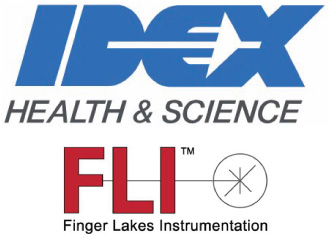
Liquid Cooling
All FLI cameras incorporate a thermo-electric cooler to cool the sensor. Maximum cooling for any given camera depends on the sensor size and ambient temperature. The Kepler Liquid Cooler can accept a flow rate of up to 0.5 gallon/minute (1.91 liter/min). Please contact FLI with your custom cooling requirements for either air, liquid, or un-cooled systems. For other families of cameras, check their specific manuals.
With liquid cooling, a Kepler cameras sensor temperature can drop an additional 10°C. A liquid cooled camera can achieve a maximum change in temperature of 40°C.
The temperature of the liquid must stay above the current dew point temperature. The liquid used must be compatible with Buna-N gaskets. We recommend Primochill PC Ice coolant. Either use antibacterial tubing or antibacterial liquid; using both in the same system may cause precipitates.

Finger Lakes Instrumentation, a division of IDEX Health & Science LLC
1250 Rochester St.
Lima, New York 14485
1250 Rochester St.
Lima, New York 14485
Phone: 585-624-3760
Email: IHSKeplerSupport@IdexCorp.com
Web: www.flicamera.com
Email: IHSKeplerSupport@IdexCorp.com
Web: www.flicamera.com
©2023 IDEX Health & Science LLC
| Connector | Standard User Interface | Additional Information |
| 1/8" ID Hose Barb | 1/8" ID Tubing | FLI recommends use of hose clamps. User supplies tubing and clamps with appropriate pressure rating for their application. |
| Quick Connect Double Shutoff | 1/8" ID Tubing | FLI supplies both female and male connectors. User supplies the interface. |
| Quick Connect Dry Break | 1/8" ID Tubing | FLI supplies both female and male connectors. User supplies the interface. |
| Custom | Per Customer Requirements | FLI is able to plumb to interfaces not listed. Please contact FLI with your connection requests. |
The following connection fittings are currently available:


Warning: Using flow rates above the recommended flow rates may cause the liquid cooling system to leak and will void the warranty.
Note: Maximum Kepler Liquid Cooler inlet pressure is 50 psig. Ensure tubing selected has the proper pressure rating. To avoid undesired pressure build up in Liquid Cooler shut off flow on the inlet side before detaching or closing outlet connections.
